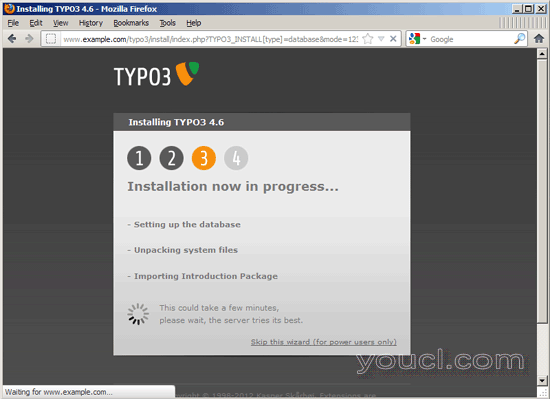运行TYPO3 4.6在Nginx(LEMP)上Debian Squeeze / Ubuntu 11.10
本教程将介绍如何在Debian Squeeze或Ubuntu 11.10系统上安装并运行TYPO3 (4.6版本)网站,该系统已安装nginx而不是Apache(LEMP = L inux + nginx(发音为“ e ngine x”)+ M ySQL + P HP)。 该指南还介绍了使用nc_staticfilecache扩展,允许TYPO3将页面缓存为完整的.html文件,从而实现更快的传送(将静态页面的响应时间增加到230,与Drupal的Boost模块类似)。 nginx是一个HTTP服务器,比Apache使用的资源少得多,并且提供了更快的网页,特别是静态文件。
我不会保证这将为您工作!
1初步说明
我想在文件根/var/www/www.example.com/web中将 TYPO3安装在名为www.example.com / example.com的虚拟机中 。
您应该有一个工作的LEMP安装,如这些教程所示:
Ubuntu用户注意事项:
因为我们必须使用root权限运行本教程的所有步骤,所以我们可以使用字符串sudo在本教程中添加所有命令,也可以通过键入来成为root
sudo su
2安装APC
APC是一个免费开放的PHP操作码cacher,用于缓存和优化PHP中间代码。 它类似于其他PHP操作码cacher,如eAccelerator和XCache。 强烈建议您安装其中一个以加快您的PHP页面。
APC可以安装如下:
apt-get install php-apc
如果您使用PHP-FPM作为FastCGI守护进程(例如在Ubuntu 11.10中安装使用PHP5(和PHP-FPM)和MySQL支持的Nginx中 ),请重新启动它,如下所示:
/etc/init.d/php5-fpm restart
如果您使用lighttpd的spawn-fcgi程序作为FastCGI守护进程(例如在使用Debian Squeeze安装Nginx with PHP5和MySQL支持 )中,我们必须终止当前的spawn-fcgi进程(在端口9000上运行),并创建一个新的。 跑
netstat -tap
找出当前的spawn-fcgi进程的PID:
root@server1:~# netstat -tap
Active Internet connections (servers and established)
Proto Recv-Q Send-Q Local Address Foreign Address State PID/Program name
tcp 0 0 *:sunrpc *:* LISTEN 734/portmap
tcp 0 0 *:www *:* LISTEN 2987/nginx
tcp 0 0 *:ssh *:* LISTEN 1531/sshd
tcp 0 0 *:57174 *:* LISTEN 748/rpc.statd
tcp 0 0 localhost.localdom:smtp *:* LISTEN 1507/exim4
tcp 0 0 localhost.localdom:9000 *:* LISTEN 1542/php5-cgi
tcp 0 0 localhost.localdo:mysql *:* LISTEN 1168/mysqld
tcp 0 52 server1.example.com:ssh 192.168.0.198:2462 ESTABLISHED 1557/0
tcp6 0 0 [::]:www [::]:* LISTEN 2987/nginx
tcp6 0 0 [::]:ssh [::]:* LISTEN 1531/sshd
tcp6 0 0 ip6-localhost:smtp [::]:* LISTEN 1507/exim4
root@server1:~#
在上面的输出中,PID是1542 ,所以我们可以杀死当前的进程如下:
kill -9 1542
之后我们创建一个新的spawn-fcgi进程:
/usr/bin/spawn-fcgi -a 127.0.0.1 -p 9000 -u www-data -g www-data -f /usr/bin/php5-cgi -P /var/run/fastcgi-php.pid
3安装TYPO3
我的www.example.com网站的文档根目录是/var/www/www.example.com/web - 如果不存在,创建如下:
mkdir -p /var/www/www.example.com/web
接下来,我们下载TYPO3(TYPO3有多种口味 - 我选择介绍包 ,因为它附带了一个完整的示例网站,如果你知道TYPO3,你也可以使用任何其他包) .tar.gz来自http://typo3.org/download/packages/的文件,并将其放在我们的文档根目录中:
cd /tmp
wget http://downloads.sourceforge.net/project/typo3/TYPO3%20Source%20and%20Dummy/TYPO3%204.6.3/introductionpackage-4.6.3.tar.gz
tar xvfz introductionpackage-4.6.3.tar.gz
cd introductionpackage-4.6.3/
mv * /var/www/www.example.com/web/
mv .htaccess /var/www/www.example.com/web/
建议使用作为用户www-data和group www-data运行的nginx守护进程将文档根和TYPO3文件写入其中:
chown -R www-data:www-data /var/www/www.example.com/web
如果您尚未为TYPO3(包括MySQL TYPO3用户)创建了MySQL数据库,则可以按如下方式进行操作(在此示例中我命名数据库typo3 ,用户名为typo3_admin ,密码为typo3_admin_password ):
mysqladmin -u root -p create typo3
mysql -u root -p
GRANT ALL PRIVILEGES ON typo3.* TO 'typo3_admin'@'localhost' IDENTIFIED BY 'typo3_admin_password';
GRANT ALL PRIVILEGES ON typo3.* TO 'typo3_admin'@'localhost.localdomain' IDENTIFIED BY 'typo3_admin_password';
FLUSH PRIVILEGES;
quit;
接下来,我们在/ etc / nginx / sites-available /目录中为www.example.com vhost创建一个nginx vhost配置,如下所示:
vi /etc/nginx/sites-available/www.example.com.vhost
server {
listen 80;
server_name www.example.com example.com;
root /var/www/www.example.com/web;
if ($http_host != "www.example.com") {
rewrite ^ http://www.example.com$request_uri permanent;
}
index index.php index.html;
location = /favicon.ico {
log_not_found off;
access_log off;
expires max;
}
location = /robots.txt {
allow all;
log_not_found off;
access_log off;
}
# Deny all attempts to access hidden files such as .htaccess, .htpasswd, .DS_Store (Mac).
location ~ /\. {
deny all;
access_log off;
log_not_found off;
}
location ~* \.(jpg|jpeg|png|gif|css|js|ico)$ {
expires max;
log_not_found off;
}
location ~* \.(cur|ico|gif|png|jpe?g|css|js|swf|woff)((\?\d\d\d\d\d\d\d\d\d\d)|(\?s=\d\d\d\d\d\d\d\d\d\d))$ {
expires max;
log_not_found off;
}
location ~* \.(cur|ico|gif|png|jpe?g|css|js|swf|woff)(\?v\d\d?\.\d\d?\.\d\d?)$ {
expires max;
log_not_found off;
}
location ~* ^(/typo3/sysext|/typo3conf/ext).*\.(cur|ico|gif|png|jpe?g|css|js|swf|woff) {
expires max;
log_not_found off;
}
location = /clear.gif {
empty_gif;
expires max;
}
location ^~ /typo3/gfx {
expires max;
}
location ^~ /typo3temp/compressor {
expires max;
}
location ~* \.(sql|htaccess|htpasswd|tpl|html5|xhtml) {
deny all;
}
location / {
if ($query_string ~ ".+") {
return 405;
}
# pass requests from logged-in users to PHP
if ($http_cookie ~ 'nc_staticfilecache|be_typo_user' ) {
return 405;
} # pass POST requests to PHP
if ($request_method !~ ^(GET|HEAD)$ ) {
return 405;
}
if ($http_pragma = 'no-cache') {
return 405;
}
if ($http_cache_control = 'no-cache') {
return 405;
}
error_page 405 = @nocache;
# serve requested content from the cache if available, otherwise pass the request to PHP
try_files /typo3temp/tx_ncstaticfilecache/$host${request_uri}index.html @nocache;
}
location @nocache {
try_files $uri $uri/ /index.php?$args;
}
location ^~ /typo3temp/tx_ncstaticfilecache {
expires 43200;
charset utf-8;
}
location ~ \.php$ {
try_files $uri =404;
include /etc/nginx/fastcgi_params;
fastcgi_pass 127.0.0.1:9000;
fastcgi_param SCRIPT_FILENAME $document_root$fastcgi_script_name;
fastcgi_index index.php;
}
} |
此配置已经包含干净的URL所需的一切 (因为try_files $ uri $ uri / /index.php?$args; @nocache位置中的行)以及从nc_staticfilecache提供文件(扩展名将缓存的文件存储在/ typo3temp / tx_ncstaticfilecache目录)。 如果没有找到缓存的文件(或者是经过身份验证的用户,POST请求,带有查询字符串的URL等),请求将传递到@nocache位置。 这意味着如果您根本不使用nc_staticfilecache扩展名,这个配置也是有效的。
接下来请确保您在/etc/nginx/mime.types中有以下行:
vi /etc/nginx/mime.types
[...]
text/x-component htc;
[...] |
要启用vhost,我们从/ etc / nginx / sites-enabled /目录创建一个符号链接:
cd /etc/nginx/sites-enabled/
ln -s /etc/nginx/sites-available/www.example.com.vhost www.example.com.vhost
重新加载nginx以使更改生效:
/etc/init.d/nginx reload
现在,我们可以通过访问http://www.example.com/typo3/install/index.php?mode=123&step=1启动基于Web的TYPO3安装程序 - 首先您必须输入安装程序的密码是joh316 by默认:
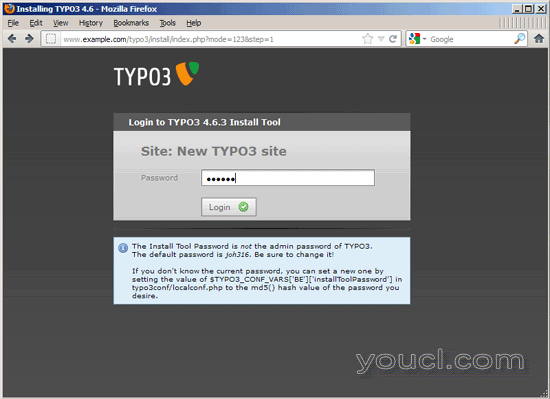
这将带您到1-2-3安装程序。 点击继续 :
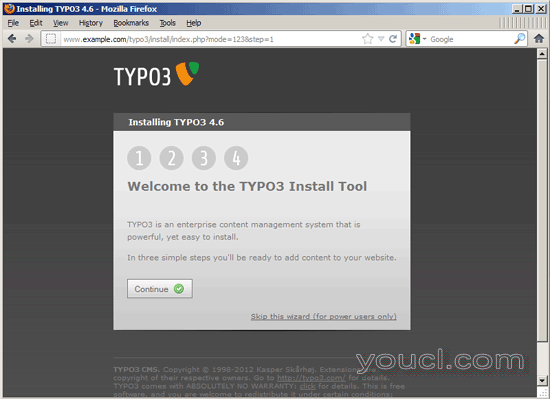
接下来填写数据库详细信息(用户: typo3_admin ;密码: typo3_admin_password从我们创建typo3数据库),然后单击继续 :
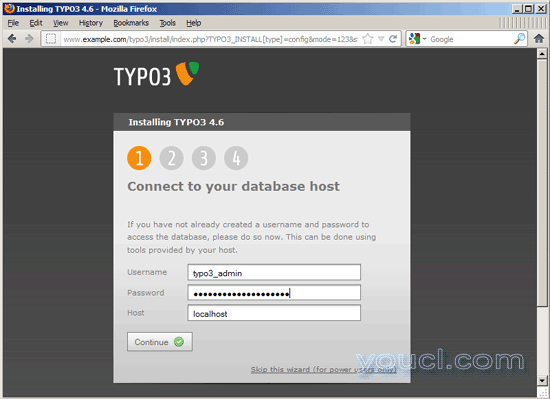
在下一页选择选择一个EMPTY现有数据库 , 然后从下拉菜单中选择typo3 。 然后点击继续 :
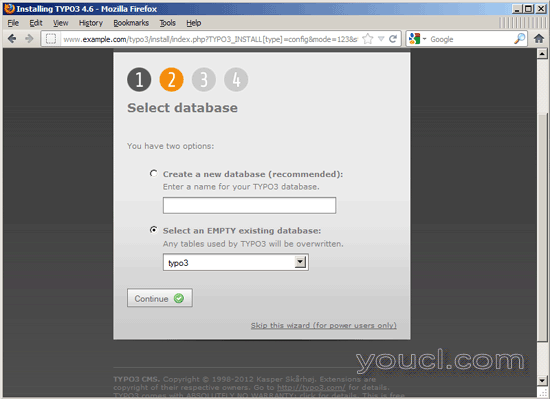
现在您必须决定是否要安装一个完全空的TYPO3系统(以便您可以从头开始使用项目),或者要使用简介包附带的演示网站填充TYPO3。
在本教程中,我选择简介包(推荐)来安装演示网站。 点击继续 :
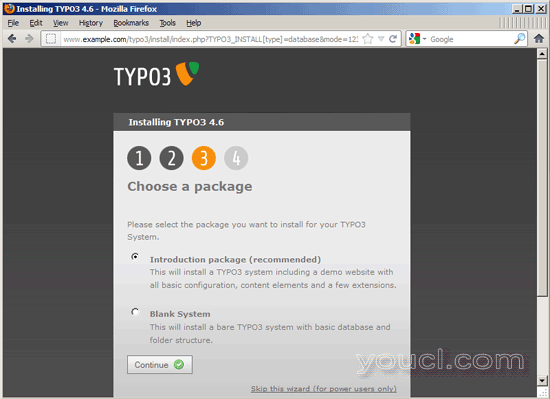
数据库和演示网站正在配置中:
